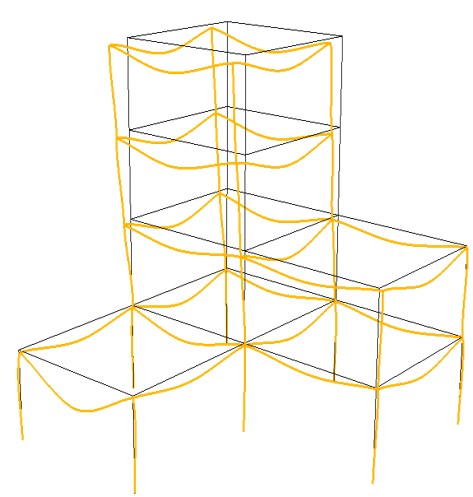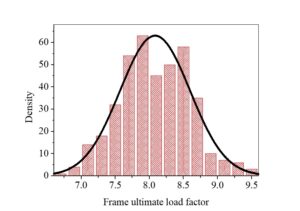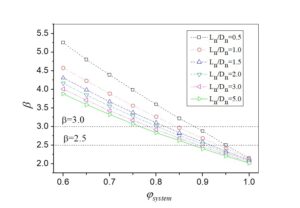System reliability-based criteria for designing steel structures by advanced analysis
Summary
The main objective of the project is to develop a “systems-based” methodology for the design of steel structures in which analysis and capacity check are carried out in a single step. This is in contrast to current design methodologies which are “member-based”, i.e. the strength of each member is considered individually and if all members have adequate strength, then the design is deemed to be adequate. In system-based design, use is made of sophisticated software to predict the strength of the entire frame whereby only an inelastic geometric nonlinear (“advanced”) analysis is required to complete the design. The advantage of systems-based design-by-analysis is that the method is potentially faster and thus more efficient, accurately predicts interactions between members including load shedding, gives greater insight of the behaviour of the structure, which promotes innovation in design, provides more uniform reliability, and equips engineers with a tool for designing common topologies of steel-framed structures as well as unusual and challenging structures for which current design standards prove inadequate.
This Project is supported by the ARC Discovery Project DP110104263.
Chief Investigators
- Prof Kim Rasmussen
- Associate Prof Hao Zhang
- Prof Bruce Ellingwood
PhD students and graduates:
- Dr Shabnam Shayan
- Dr Wenyu (Peter) Liu
- Dr Francisco de Sena Cardoso
- Dr Gengbo Chen

Project outcomes and significance
The project has produced a framework for the rigorous statistical assessment of the system strength which considers structural redundancy, consequences of failure and statistical variations in loading and variables affecting the frame strength. The framework entails Monte-Carlo type simulations of frames with randomly generated values of all governing variables to determine the statistical distribution of the resistance, followed by a First Order Reliability Method (FORM) analysis of the system. Strength reduction factors, referred to as resistance factors in Australian and US terminology and partial factors in European terminology, have been calculated for a wide range of target reliability indices for the following types of structures: 2D and 3D hot-rolled frames, cold-formed steel portal frames and storage racks, scaffolds as well as reticulated spherical and cylindrical arches. The design-by-advanced-analysis method has been coined the Direct Design Method (DDM).
DDM provisions have been incorporated in the Australian standards for the structural design of cold-formed steel structures (AS/NZS4600), steel storage racks (AS4084) and scaffolds (AS3610.2).


Publications
- S. Shayan, K.J.R. Rasmussen and H. Zhang, “On the modelling of initial geometric imperfections of steel frames in advanced analysis”, Journal of Constructional Steel Research, 2014, Vol. 98, 167-177.
- S. Shayan, K.J.R. Rasmussen and H. Zhang, “Probabilistic modelling of residual stress in advanced analysis of steel structures”, Journal of Constructional Steel Research, 2014, Vol. 101, 407-414.
- S. Shayan and K.J.R. Rasmussen, “A model for warping transmission through joints of steel frames”, Thin-Walled Structures, 2014, Vol. 82, 1-12.
- F. Sena Cardoso and K.J.R. Rasmussen, “Behavior and design of concentrically loaded T-section steel columns”, Journal of Structural Engineering, 2014, Vol. 140(7),04014039.
- G. Chen, H. Zhang, K.J.R. Rasmussen and F. Fan, “Modelling geometric imperfections of spatial latticed structures considering correlations of node imperfections”, Applied Mechanics and Materials, 2014, Vol. 553, 576-581.
- G. Chen, H. Zhang, K.J.R. Rasmussen and F. Fan, “Modeling geometric imperfections for reticulated shell structures using random field theory”, Engineering Structures, 2016, Vol. 126, 481-489.
- H. Zhang, S. Shayan, K.J.R. Rasmussen and B.R. Ellingwood, “System-based design of planar steel frames, II: Reliability results and design recommendations”, Journal of Constructional Steel Research, 2016, Vol. 123, 154-161.
- H. Zhang, S. Shayan, K.J.R. Rasmussen and B.R. Ellingwood, “System-based design of planar steel frames, I: Reliability framework”, Journal of Constructional Steel Research, 2016, Vol. 123, 135-143.
- F. Sena Cardoso and K.J.R. Rasmussen, “Finite element (FE) modelling of storage rack frames”, Journal of Constructional Steel Research, 2016, Vol. 126, 1-14.
- W. Liu, K.J.R. Rasmussen and H. Zhang, “Systems Reliability for 3D Steel Frames Subject to Gravity Loads”, Structures, 2016, Vol. 8, 170-182.
- W. Liu, K.J.R. Rasmussen and H. Zhang, “Modelling and probabilistic study of the residual stress of cold-formed hollow steel sections”, Engineering Structures, 2018, Vol. 150, 986-995.
- W. Liu, H. Zhang, and K.J.R. Rasmussen, “System reliability-based Direct Design Method for space frames with cold–formed steel hollow sections”, Engineering Structures, 2018, Vol. 166, 79-92.
- W. Liu, H. Zhang, K.J.R. Rasmussen and S. Yan, “System-based limit state design criterion for 3D steel frames under wind loads”, Journal of Constructional Steel Research, 2019, Vol. 157, 440-449.
- F. Sena Cardoso, H. Zhang, K.J.R. Rasmussen and S. Yan, “Reliability calibrations for the design of cold-formed steel portal frames by advanced analysis”, Engineering Structures, 2019, Vol. 182, 164-171.
- F. Sena Cardoso, H. Zhang and K.J.R. Rasmussen, “System reliability-based criteria for the design of steel storage rack frames by advanced analysis: Part II – Reliability analysis and design applications”, Thin-Walled Structures, 2019, Vol. 141, 725-739.
- F. Sena Cardoso, K.J.R. Rasmussen and H. Zhang, “System reliability-based criteria for the design of steel storage rack frames by advanced analysis: Part I – Statistical characterisation of system strength”, Thin-Walled Structures, 2019, Vol. 141, 713-724.
- C. Wang, H. Zhang, K.J.R. Rasmussen, J. Reynolds and S. Yan, “System reliability-based limit state design of support scaffolding systems”, Engineering Structures, 2020, Vol. 116, doi.org/10.1016/j.engstruct.2020.110677.
- I. Arrayago, H. Zhang and K.J.R. Rasmussen, “Simplified expressions for reliability assessments in code calibration”, Engineering Structures, 2022, Vol. 256, doi.org/10.1016/j.engstruct.2022.114013.
- I. Arrayago and K.J.R. Rasmussen, “Influence of the imperfection direction on the ultimate response of steel frames in advanced analysis”, Journal of Constructional Steel Research, 2022, Vol. 190, doi.org/10.1016/j.jcsr.2022.107137.

